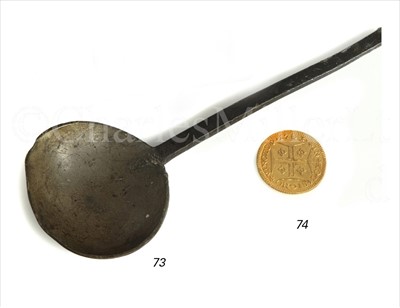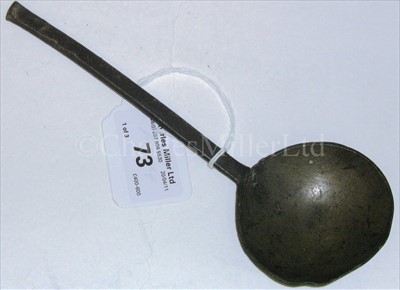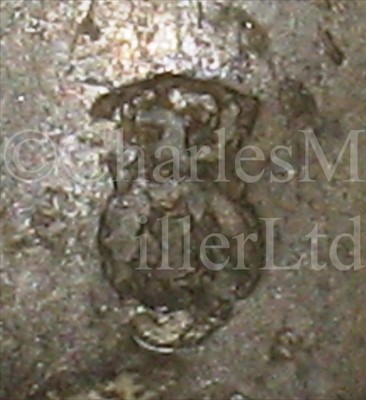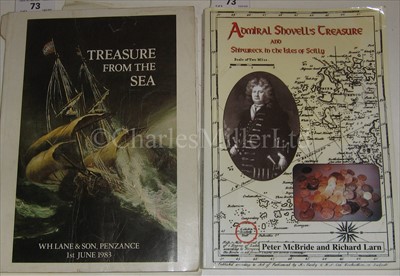20th Apr, 2011 12:00
Maritime and Scientific Models, Instruments & Art (Princess)
73
[M] A PEWTER SPOON RECOVERED FROM THE WRECK OF SIR...
A PEWTER SPOON RECOVERED FROM THE WRECK OF SIR CLOWDESLEY SHOVELL'S FLAGSHIP H.M.S. ASSOCIATION (1707)
with panelled stem to fig-shaped bowl impressed with worn maker's mark for 'R I' -- 7in. (18cm.) long; together with W.H. Lane catalogue from 1983; and McBride & Larn's volume Admiral Shovell's Treasure
(3)
Literature: McBride and Larn: Admiral Shovell's Treasure, Troutbeck Press 1999, p. 64, this lot illustrated on left.; W.H. Lane & Son, Penzance auction catalogue: Treasure From The Sea, 1st June 1983, lot 552.
Although the War with France over the Spanish succession was still at its height, as the summer of 1707 drew to its close, the bulk of the British Mediterranean Fleet prepared to return to England for the Winter. Sailing orders were issued on 29th September and thirteen warships, including the Flagship Association, set sail from Gibraltar under the command of Rear-Admiral Sir Cloudesley Shovell, C. in C. Mediterranean. It had been an eventful year and the fleet, in close co-operation with the Duke of Savoy, had taken an active part in the combined attack on Toulon. Even though the final assault had not been a success, many French ships had been destroyed and the town heavily bombarded. Such action had necessitated refitting and the fleet was more than ready for the security of Spithead. On the voyage northwards the squadron encountered exceptionally severe weather with the result that on 22nd October the Admiral ordered the fleet to heave-to and take soundings. A lengthy conference concluded the position to be in the latitude of Ushant, near the coast of France, but in actual fact the appalling weather had driven them one hundred miles west of this point, and only two hours sailing time south of the Isles of Scilly. In the mistaken belief that the clear Channel lay ahead of them, the flagship herself led the way into the storm. Daylight faded, the weather worsened; the compact line of the ships slowly dispersed until at about 8.20p.m., without warning the Association struck the Outer Ledge of the Gilstone Reef. Despite the fact that the Admiral's barge had time to get away, there were no survivors, and the ship broke up and sank within minutes. Three other vessels -- Romney, Eagle and Firebrand -- also foundered in the same vicinity and about two thousand men perished alongside Sir Cloudesley Shovell.
Within the last forty years, all four of these wrecks have been located and carefully explored; numerous artifacts, as well as a significant quantity of coins, have been recovered.
with panelled stem to fig-shaped bowl impressed with worn maker's mark for 'R I' -- 7in. (18cm.) long; together with W.H. Lane catalogue from 1983; and McBride & Larn's volume Admiral Shovell's Treasure
(3)
Literature: McBride and Larn: Admiral Shovell's Treasure, Troutbeck Press 1999, p. 64, this lot illustrated on left.; W.H. Lane & Son, Penzance auction catalogue: Treasure From The Sea, 1st June 1983, lot 552.
Although the War with France over the Spanish succession was still at its height, as the summer of 1707 drew to its close, the bulk of the British Mediterranean Fleet prepared to return to England for the Winter. Sailing orders were issued on 29th September and thirteen warships, including the Flagship Association, set sail from Gibraltar under the command of Rear-Admiral Sir Cloudesley Shovell, C. in C. Mediterranean. It had been an eventful year and the fleet, in close co-operation with the Duke of Savoy, had taken an active part in the combined attack on Toulon. Even though the final assault had not been a success, many French ships had been destroyed and the town heavily bombarded. Such action had necessitated refitting and the fleet was more than ready for the security of Spithead. On the voyage northwards the squadron encountered exceptionally severe weather with the result that on 22nd October the Admiral ordered the fleet to heave-to and take soundings. A lengthy conference concluded the position to be in the latitude of Ushant, near the coast of France, but in actual fact the appalling weather had driven them one hundred miles west of this point, and only two hours sailing time south of the Isles of Scilly. In the mistaken belief that the clear Channel lay ahead of them, the flagship herself led the way into the storm. Daylight faded, the weather worsened; the compact line of the ships slowly dispersed until at about 8.20p.m., without warning the Association struck the Outer Ledge of the Gilstone Reef. Despite the fact that the Admiral's barge had time to get away, there were no survivors, and the ship broke up and sank within minutes. Three other vessels -- Romney, Eagle and Firebrand -- also foundered in the same vicinity and about two thousand men perished alongside Sir Cloudesley Shovell.
Within the last forty years, all four of these wrecks have been located and carefully explored; numerous artifacts, as well as a significant quantity of coins, have been recovered.
Sold for £496
Estimated at £400 - £600
(inc. buyer's premium of 24%)
A PEWTER SPOON RECOVERED FROM THE WRECK OF SIR CLOWDESLEY SHOVELL'S FLAGSHIP H.M.S. ASSOCIATION (1707)
with panelled stem to fig-shaped bowl impressed with worn maker's mark for 'R I' -- 7in. (18cm.) long; together with W.H. Lane catalogue from 1983; and McBride & Larn's volume Admiral Shovell's Treasure
(3)
Literature: McBride and Larn: Admiral Shovell's Treasure, Troutbeck Press 1999, p. 64, this lot illustrated on left.; W.H. Lane & Son, Penzance auction catalogue: Treasure From The Sea, 1st June 1983, lot 552.
Although the War with France over the Spanish succession was still at its height, as the summer of 1707 drew to its close, the bulk of the British Mediterranean Fleet prepared to return to England for the Winter. Sailing orders were issued on 29th September and thirteen warships, including the Flagship Association, set sail from Gibraltar under the command of Rear-Admiral Sir Cloudesley Shovell, C. in C. Mediterranean. It had been an eventful year and the fleet, in close co-operation with the Duke of Savoy, had taken an active part in the combined attack on Toulon. Even though the final assault had not been a success, many French ships had been destroyed and the town heavily bombarded. Such action had necessitated refitting and the fleet was more than ready for the security of Spithead. On the voyage northwards the squadron encountered exceptionally severe weather with the result that on 22nd October the Admiral ordered the fleet to heave-to and take soundings. A lengthy conference concluded the position to be in the latitude of Ushant, near the coast of France, but in actual fact the appalling weather had driven them one hundred miles west of this point, and only two hours sailing time south of the Isles of Scilly. In the mistaken belief that the clear Channel lay ahead of them, the flagship herself led the way into the storm. Daylight faded, the weather worsened; the compact line of the ships slowly dispersed until at about 8.20p.m., without warning the Association struck the Outer Ledge of the Gilstone Reef. Despite the fact that the Admiral's barge had time to get away, there were no survivors, and the ship broke up and sank within minutes. Three other vessels -- Romney, Eagle and Firebrand -- also foundered in the same vicinity and about two thousand men perished alongside Sir Cloudesley Shovell.
Within the last forty years, all four of these wrecks have been located and carefully explored; numerous artifacts, as well as a significant quantity of coins, have been recovered.
with panelled stem to fig-shaped bowl impressed with worn maker's mark for 'R I' -- 7in. (18cm.) long; together with W.H. Lane catalogue from 1983; and McBride & Larn's volume Admiral Shovell's Treasure
(3)
Literature: McBride and Larn: Admiral Shovell's Treasure, Troutbeck Press 1999, p. 64, this lot illustrated on left.; W.H. Lane & Son, Penzance auction catalogue: Treasure From The Sea, 1st June 1983, lot 552.
Although the War with France over the Spanish succession was still at its height, as the summer of 1707 drew to its close, the bulk of the British Mediterranean Fleet prepared to return to England for the Winter. Sailing orders were issued on 29th September and thirteen warships, including the Flagship Association, set sail from Gibraltar under the command of Rear-Admiral Sir Cloudesley Shovell, C. in C. Mediterranean. It had been an eventful year and the fleet, in close co-operation with the Duke of Savoy, had taken an active part in the combined attack on Toulon. Even though the final assault had not been a success, many French ships had been destroyed and the town heavily bombarded. Such action had necessitated refitting and the fleet was more than ready for the security of Spithead. On the voyage northwards the squadron encountered exceptionally severe weather with the result that on 22nd October the Admiral ordered the fleet to heave-to and take soundings. A lengthy conference concluded the position to be in the latitude of Ushant, near the coast of France, but in actual fact the appalling weather had driven them one hundred miles west of this point, and only two hours sailing time south of the Isles of Scilly. In the mistaken belief that the clear Channel lay ahead of them, the flagship herself led the way into the storm. Daylight faded, the weather worsened; the compact line of the ships slowly dispersed until at about 8.20p.m., without warning the Association struck the Outer Ledge of the Gilstone Reef. Despite the fact that the Admiral's barge had time to get away, there were no survivors, and the ship broke up and sank within minutes. Three other vessels -- Romney, Eagle and Firebrand -- also foundered in the same vicinity and about two thousand men perished alongside Sir Cloudesley Shovell.
Within the last forty years, all four of these wrecks have been located and carefully explored; numerous artifacts, as well as a significant quantity of coins, have been recovered.
Auction: Maritime and Scientific Models, Instruments & Art (Princess), 20th Apr, 2011




